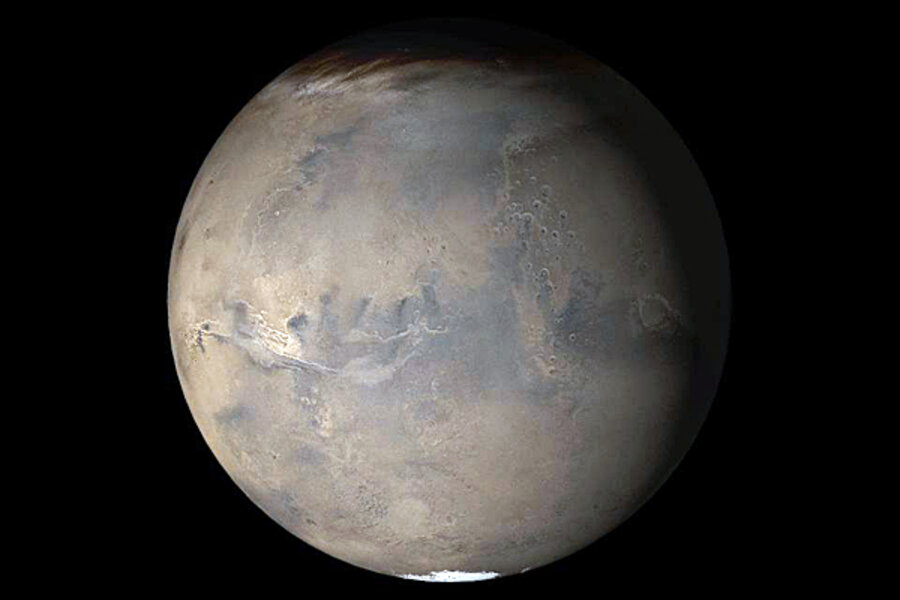Looking for life on Mars? Dig deep, new study suggests.
Loading...
If you plan to hunt for life on Mars, past or present, bring a back hoe.
Early in the planet's history, the most likely locations for microbe metropolises were under the Martian surface in wet environments warmed by hydrothermal activity, according to a new study.
The work, published in Thursday's issue of the journal Nature, adds a fresh wrinkle to the debate over the climate history of early Mars and how hospitable the young planet would have been to simple forms of life.
Key to that hospitality is whether or not early Mars – in this case, Mars 3 billion to 4 billion years ago – would have had a climate sufficiently warm to allow water to accumulate on the surface long enough for life to emerge.
For years, planetary scientists could marshal evidence suggesting that the red planet was a largely dessicated orb from the get-go, where water occasionally pooled and flowed for geologically brief periods in limited regions on its surface.
Through about 2000, Mars orbiters failed to turn up evidence of clays or other minerals that would form in the presence of liquid water, explains Bethany Ehlmann, a planetary scientist at the California Institute of Technology in Pasadena, Calif.
Others pointed to the northern lowlands as resembling an ancient ocean floor, as well as to other evidence suggesting that early in Mars' history, it hosted water on its surface.
But as the US and European space programs sent advanced orbiters and landers to explore the planet over the past decade, evidence for a warm, wet early Mars began to build.
NASA's rover Opportunity found evidence of past surface-water pooling, notes Dr. Elhmann, the lead author of the new study. Research was conducted by a team of astronomers from the US and France.
More globally, evidence came from instruments on the European Space Agency's Mars Express orbiter and later from data gathered by NASA's Mars Reconnaissance Orbiter.
"We were seeing that clays were all over the planet," she says, as well as surface deposits of other minerals that form in the presence of water.
The clays appeared as layers in canyon and valley walls at levels deep enough to date to Mars' Noachian Period, a slice of geologic time on the planet that spanned 400 million years, beginning about 4.1 billion years ago. They also appear in the material ejected by impacts, which dredge up material from deep in the crust.
But did the clay deposits the orbiters map really form on the surface, which would imply abundant surface water?
That's the question this new study tries to answer.
The team notes that on Earth, clays also form from hydrothermal activity in the crust. Hydrothermal clays form in the presence of water, but they form with relatively small amounts of water compared with surface clays. So they tend to retain the mix of minerals in the rock that spawns them – volcanic rock known as basalts.
Clays forming on the surface tend to show a much different make-up, altered by flowing water that can leach minerals from the clays.
Typically, clays formed underground have higher concentrations of iron and magnesium, plus a smattering of other minerals that form at temperatures of up to 400 degrees Celsius (752 degrees Fahrenheit). Water leaching of surface clays leaves them with high abundances of aluminum.
Data from the orbiters indicate that far more of Mars' clay deposits show a hydrothermal pedigree than a surface pedigree.
The upshot: If Mars had a warm, wet environment early in its history, it was underground.
"Embarking on this project was important," Dr. Ehlmann says. Although the constant overturning of Earth's crust has erased virtually all records of what was happening 3.5 billion years ago, some of the few rock formations geologists have found from that period show evidence for life, she says.
Understanding the clays on Mars opens a window on a similar period and whether the environment was hospitable for life there as well.
"We think our data point to the fact that the longest-duration, water-rich environments would have been in the subsurface" on Mars, she says.
It could have been a fecund incubator, she suggests, noting that on Earth, the vast majority of microbial biomass is thought to live in Earth's crust, not at the surface.





